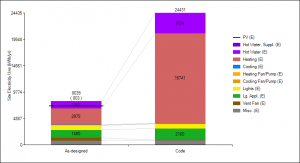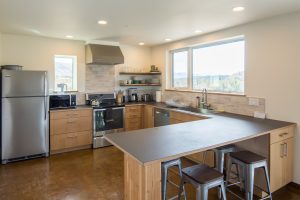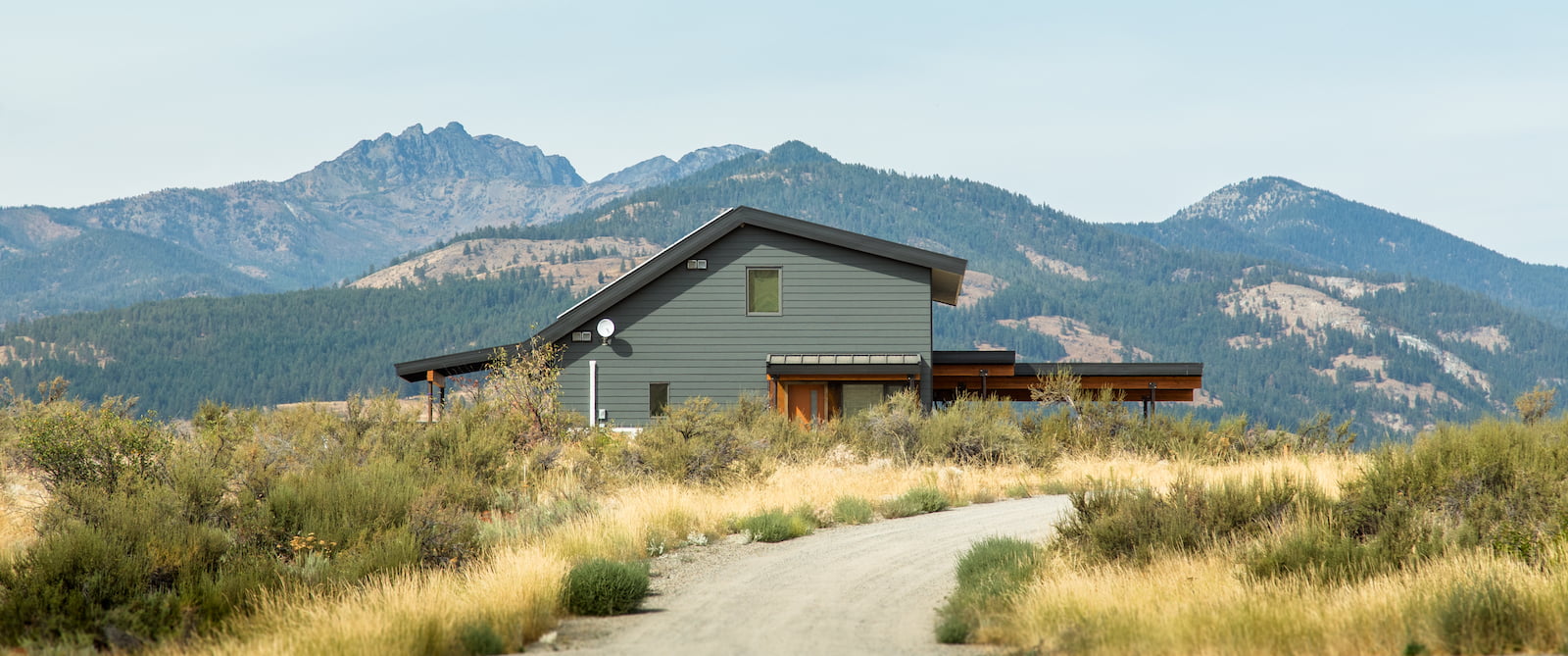In 2018, David Reddy, Lisa Dulude, Eric Thomas, and Alexandra Salmon formed Artemisia LLC to build and operate a vacation rental in central Washington state. Motivated by their personal values and professional skills, they set their sights on making it a zero energy building. Zero Energy Project talks with Artemisia partners about the vision behind the project and its success.
ZEP: Tell us about your zero energy vacation rental.
Artemisia: We built what we believe is the first zero energy nightly vacation rental, an 1,815-square-foot, 3-bedroom, 100% electric grid-tied net-zero energy home located in the beautiful Methow Valley. It feels wonderfully isolated, but you don’t need to get into your car to get to restaurants, shops, and other amenities in the nearby small town of Winthrop.
ZEP: What were your motivations and goals, and to what degree did you meet them?
Artemisia: All four of us share a deep concern about climate change and a strong interest in reducing the carbon footprint of homes. Eric and Alex had built a previous zero energy home in Seattle. Dave and Lisa both work in the fields of sustainability and energy efficiency. They wanted to apply their knowledge by “walking-the-walk” in their own project. We all enjoyed the challenge of pushing the energy-efficiency envelope while sticking to a budget.
Our goal was simple: to build a highly energy efficient, all-electric zero energy design that was achieved on a modest budget and was financially profitable. In the first year of operation, we achieved our goal by producing more solar energy than the home used over a 12-month period.
ZEP: How much additional are you paying per month on your mortgage to cover the added costs of getting to zero and how does that compare to your monthly energy savings?
We weren’t able to get a traditional mortgage for this project because it is owned by the LLC our two families set up. However, if we were to finance the $26,000 price difference of getting to net-zero over 30 years at 3.92%, it would add about $123 per month to the mortgage bill. When you factor in the $190 per month utility bill savings, we would actually come out $67 per month ahead by going the zero energy route, right from the very first month.
ZEP: Can you break down the added cost to get to net-zero versus a similar home built to code?
Artemisia: In general, we tried to prioritize energy efficiency and rooftop solar over costly finishes, and in so doing, we believe we kept our construction budget in line with or below other vacation homes in the area. That said, we estimated that building our home net-zero cost about $26,000 more than if we had built the identical design to code-minimum standards.
Rooftop Solar
The 5.4 kW PV system, with installation, was just under $20,000, or about $3.50/Watt. The remote location was a factor in a higher system cost. However, the cost of the solar was offset by a federal tax credit of 30% of the cost of the system, as well as a small production incentive we will receive annually from Washington State.
Framing
We used Structural Insulated Panels (SIPs) for the building envelope. They cost up to 20% more than traditional 2×6 framing. SIPs may have added about $5,500 to the cost of our home, although we did not get bids for traditional framing. One of the benefits of SIPs construction is lower labor costs, but we found our labor costs to be on par with stick building because we had to bring in a framer familiar with SIPs construction from out of state.
Windows
We chose vinyl-framed windows, which were less than wood or fiberglass. However, to achieve our zero energy goal, we went with triple-pane instead of double-pane, which added about 20% or $2,500 to our window package price.
HVAC
Our fresh-air ventilation system makes use of a LifeBreath heat recovery ventilator (HRV), which cost about $3,900 installed. If we had gone the code-minimum route, we might have gotten away with a whole-house, exhaust-only system for less than half that price, but we would have paid more in heating and cooling costs, and it could have led to cold drafts in the winter.
Appliances
We chose an 80-gallon Voltex heat-pump water heater from AO Smith, which retails for about $2,100. A low-end propane water heater costs about $1,200. Even though the initial cost was higher for the heat pump water heater, it was a far better deal because propane is more expensive than electricity and the heat pump water heater is significantly more efficient than the propane water heater. Choosing efficient electric appliances, such as our heat pump clothes dryer and induction range, added about $1,000 over their less-efficient electric or propane counterparts.
A back-of-the-envelope calculation shows that we spent roughly $32,000 to meet our net-zero goal, $6,000 of which came back as a federal tax rebate, for a net total of $26,000. Our construction costs totalled about $300,000, so we would estimate our incremental cost of achieving net-zero to be roughly 8.7%.
ZEP: How do you calculate your saving on energy bills each month?
Artemisia: We pay only the $32 base service charge for our local electric co-op and no propane or gas bill. Our utility estimates the average monthly electricity bill in the area to be $120. The cost to refill a propane tank would average out to about $100 per month. So we would estimate our average monthly energy savings to be about $190. For a limited time, Washington State will also be paying us a production credit for each kilowatt hour our solar panels generate, which we estimate will add up to about $1,200 per year.
Projected energy usage of our zero energy home (before rooftop solar) versus the same design built to code-minimum standards

ZEP: What construction cost saving strategies did you find particularly helpful?
Artemisia: Simplicity is key. We kept the design as close to a cube as possible, without any bump outs or complicated roof sections. We carefully selected simple, modern finishes that saved money and are still attractive so we could put most of our resources into a high-performance building envelope, with triple-pane windows, SIPs construction, and careful attention to air sealing.
Good design can reduce the need for expensive mechanical systems. Our heating system consists of just two low-cost Panasonic Exterios XE mini-split heat pumps and one electric-resistance cove heater. The heat pumps also serve as air conditioners.
We reduced costs further by putting in plenty of sweat equity, acting as our own general contractor, and doing a lot of the finish work ourselves.
Dave, who is co-owner of a local energy-efficiency consulting firm, used NREL’s BEopt software to model the home’s energy usage and optimize the PV system size for a home built in an area where there are few other benchmarks for net-zero homes. The energy model predicted annual energy use would be 7,600 kWh under typical weather conditions. In 2018, which had more extreme cold weather than expected, the actual energy use of the home was 8,100 kWh.
ZEP: How do renters’ habits affect the zero energy goal?
Artemisia: The habits of a home’s occupants has the largest impact on energy use, and we had to build in a large margin of error when calculating the renewable energy we would need to offset usage. While we have met our zero energy goal, at times we have come uncomfortably close to using more energy than we produced. We are able to monitor solar generation and usage, and usage clearly spikes with certain groups of guests.
We recently installed the Intensis Home system to control the space heating heat pumps remotely via WiFi, as well as the heat recovery ventilation system. We hope to save a significant amount of energy by automatically lowering the thermostat and HRV flow rate when guests check out and raise the temperature right before the next group checks in.
ZEP: Has making your vacation rental zero energy helped attract renters?
Artemisia: Travelers seem to love the house, and we have gotten great reviews. It’s hard to know if people are choosing our home over others for the zero energy feature, but many guests have commented on wanting to check out a zero energy home when they were making their booking requests or in their review. During the winter skiing season and the summer peak, the house is rented almost every weekend and many weekdays as well. The rental income more than covers operating expenses and produces a small stream of income. In addition, we are able to enjoy the house ourselves.
ZEP: What have you learned that you would like to share?
Artemisia: This is the second home we have built following a similar basic formula: SIPs construction, triple-pane vinyl windows with wood sills, heat pumps for space heating and water heating, a basic two-story, cube-shaped footprint, lots of south-facing windows, and stained concrete floors. It’s an approach we learned from Ted Clifton Sr., who designed the previous house we built in Seattle, and his son, also named Ted Clifton, who was the contractor. Of course, there were others who contributed to the final design of our Winthrop house and refined that basic formula, not least Dave, who did the energy calculations and completed the 3-D model of the home. But, when all was said and done, we stuck to that same original idea because it’s a very cost-effective way to build an extremely high-performing, beautiful home that will save thousands of dollars on utility bills over the years.
We also learned about the importance of air sealing over the course of building this home. It was the first time we were involved with doing it ourselves, and it’s easy to see how this step doesn’t receive the attention it deserves. It was a painstaking, slow process to do it right, caulking every joint and foaming every crack, but our work paid off, with a blower-door test measuring just .50 ACH, beating the extremely rigorous Passive House standard. And it’s easy to see how an oblivious builder could easily gloss over it and hide their work behind the drywall. For owners building a zero energy house, we would encourage you to keep a close eye on the air-sealing process and specify before construction begins how you want it done. Better yet, if you have the time and inclination, learn to do it yourself!
Zero Energy is Profitable
Through this project we have demonstrated how zero energy can be profitable for a small business. Through simple design and giving priority to the function of the building over the cosmetics, we accomplished our goal.
David Reddy, Lisa Dulude, Eric Thomas, and Alexandra Salmon established the Artemisia LLC to develop and manage their vacation rental in Winthrop, Washington. They blog about their project at artemisiacabin.com.

